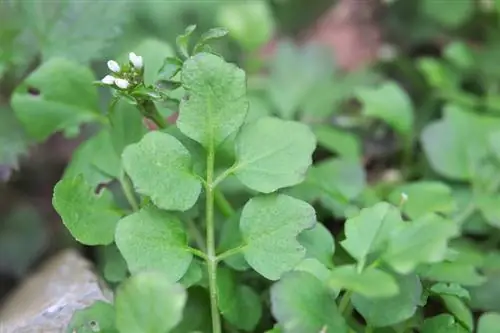- Author admin [email protected].
- Public 2023-12-16 16:46.
- Last modified 2025-01-23 11:20.
Weeds or wild weeds? Many garden owners ask themselves this question when they see the hairy foamweed. This is usually immediately followed by the question: How do I get the herb out of my garden once and for all?

How can you combat hairy foamweed?
To effectively combat hairy foamweed, it should be removed before seed formation by hoeing and weeding without using chemicals. Alternatively, you can consume the edible herb yourself in small quantities to control its spread.
Like many other wild herbs, hairy foamweed is very persistent. Wherever it feels comfortable, it multiplies very easily and is difficult to completely eliminate. It was probably spread through container goods from tree nurseries and planted in home gardens together with the purchased perennials and trees.
Where does the hairy foamweed grow?
The inconspicuous-looking hairy foamweed grows not only in perennial beds and flower borders but also on paths, on the edges of walls and even in the joints of paving stones. It likes nutrient-rich, lime-free and nitrogen-containing soil, which can be sandy and slightly acidic.
Is the hairy foamweed edible?
The hairy foamwort is not only edible but also very tasty. The mustard oil glycosides it contains make it taste slightly spicy, similar to cress. As the leaves age, they become somewhat bitter, so they are better consumed young. Just like meadowfoam, you can simply enjoy the hairy foamwort on a sandwich, refine salads and soups with it or prepare spicy herbal dishes.
Don't consume the hairy foamweed in large quantities, otherwise it could irritate your stomach or kidneys. In small quantities, however, it is beneficial to he alth. It contains some medicinal ingredients. In addition to the mustard oil glycosides already mentioned, these include vitamin C, tannins and bitter substances as well as iron and calcium. The areas of application are as diverse as the ingredients. Foam herb has an anti-inflammatory, digestive, blood-purifying and metabolism-stimulating effect.
Fighting hairy foamweed
The use of chemicals is not necessary to combat hairy foamweed. Although hoeing and weeding are more laborious, they are just as successful and much more environmentally friendly. It is best to remove the foamweed before seeds form, because the seeds sometimes even survive composting.
The most important things in brief:
- edible in small quantities
- effectively healing
- easy to hoe and weed
- do not use chemicals
Tip
Add foamweed to your diet occasionally, this is the most effective way to combat it.






